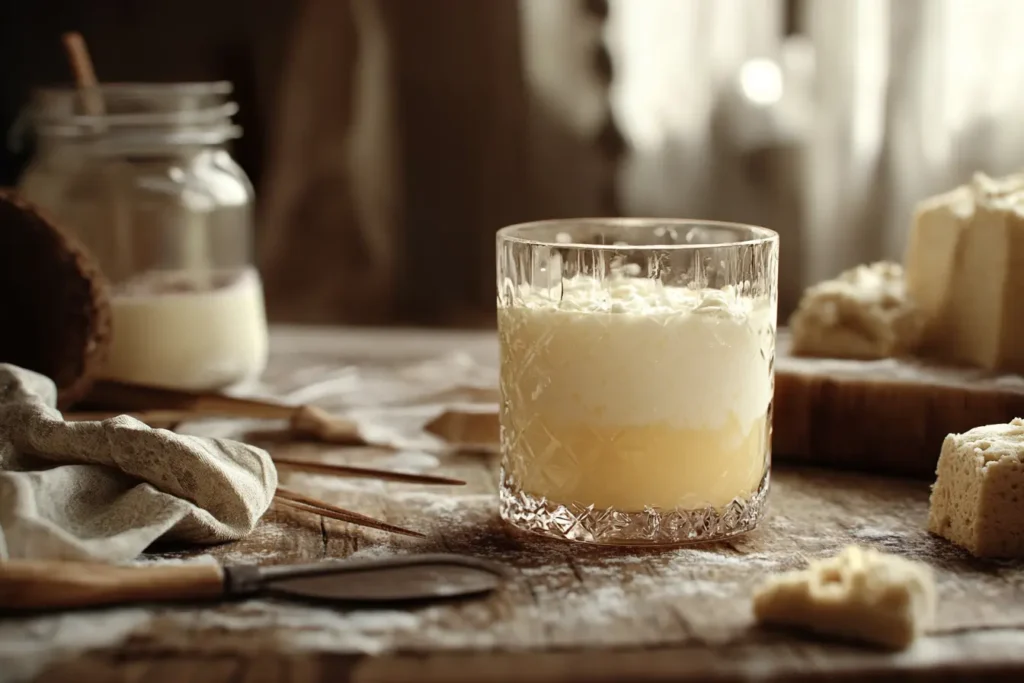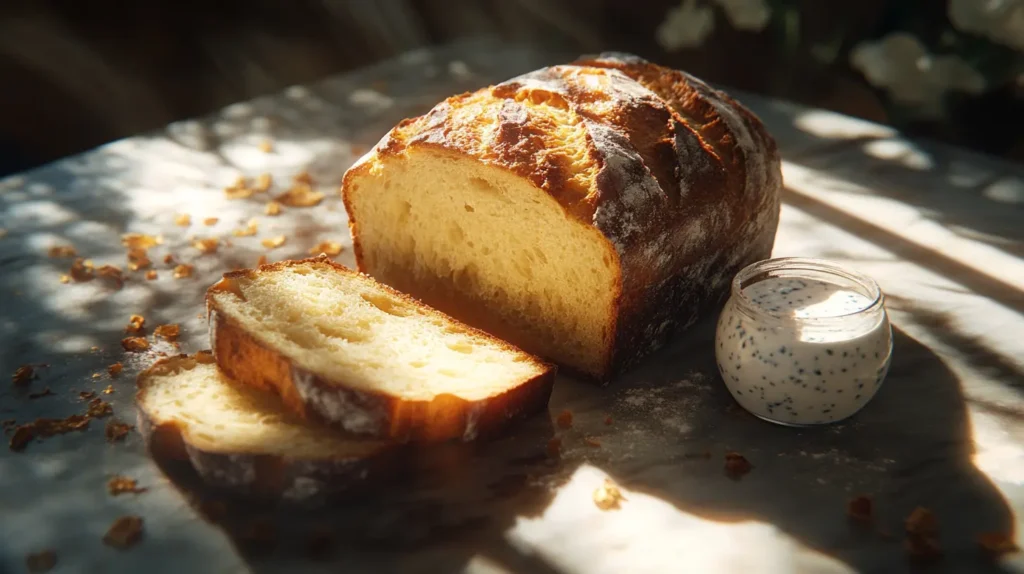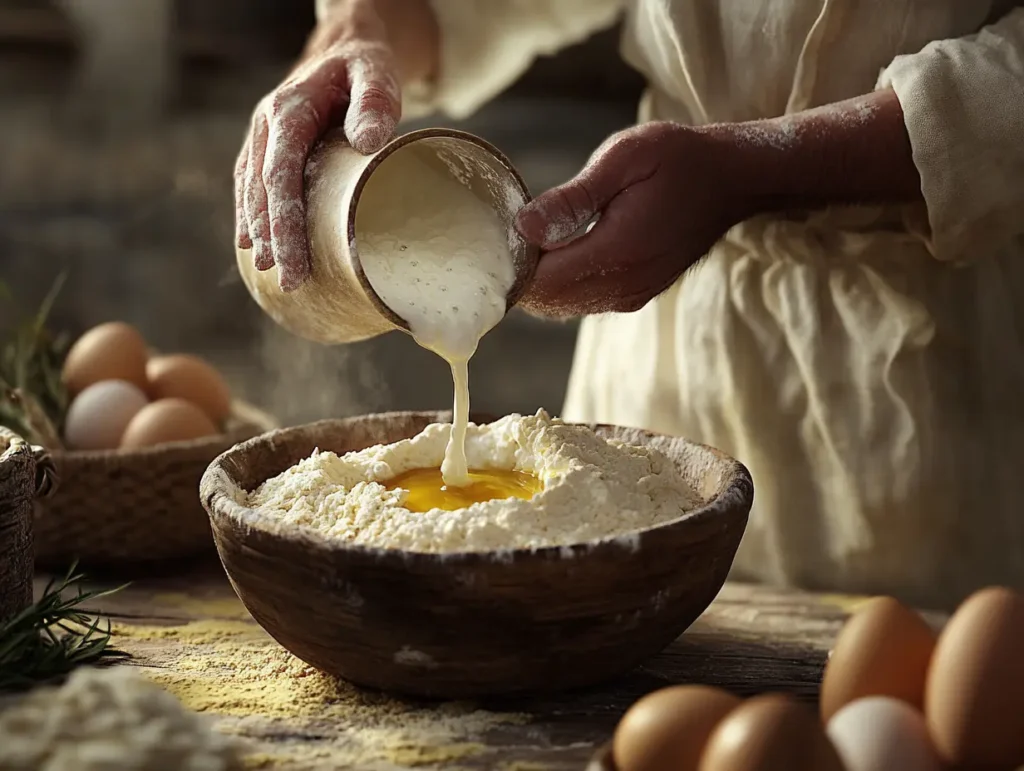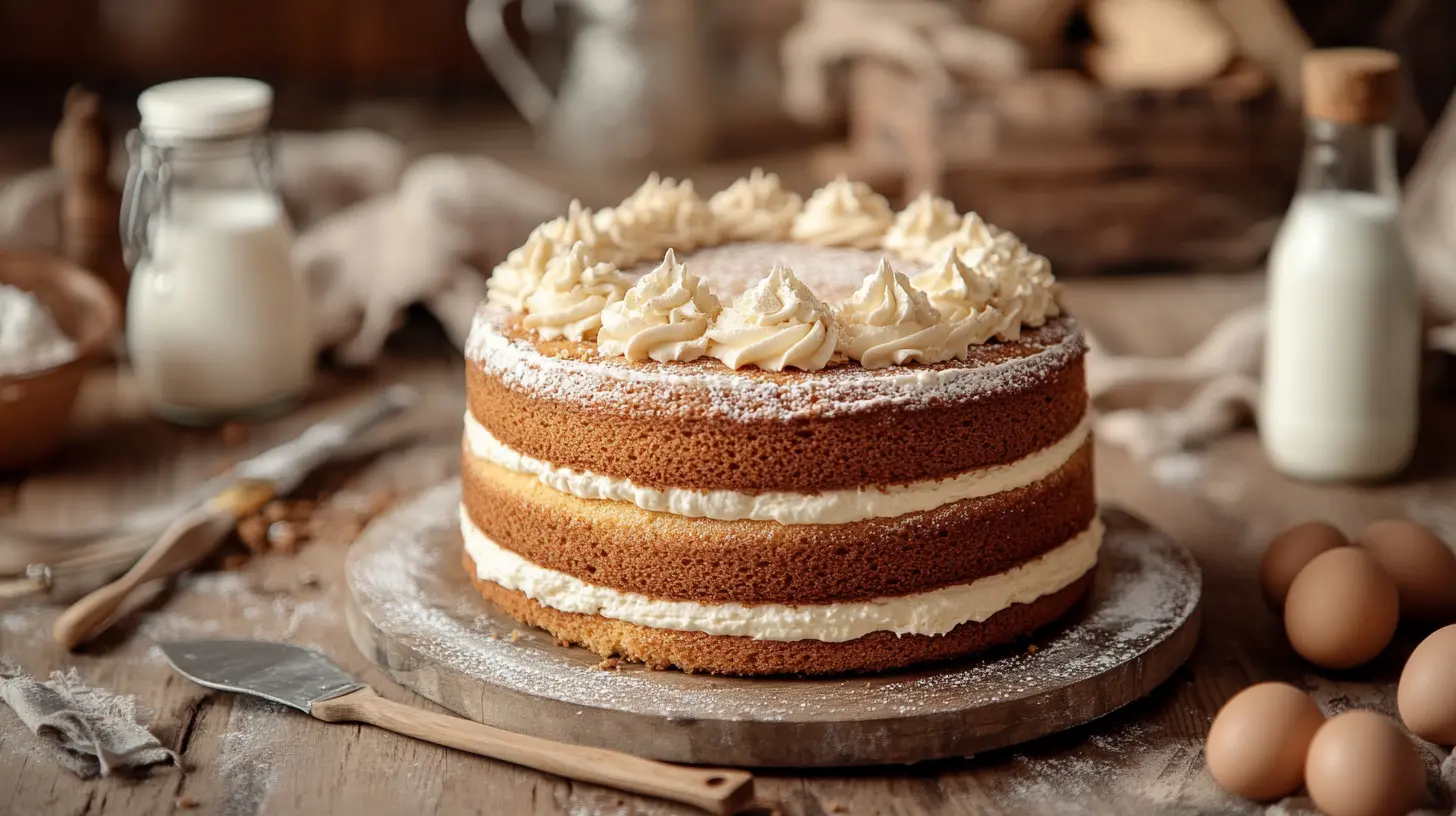Introduction to Kefir in Baking
Baking with kefir might sound fancy or complicated, but it’s not. In fact, it’s a simple, effective way to transform your baked goods into moist, tangy delights. Whether you’re whipping up pancakes, muffins, or even bread, kefir adds a unique twist that’s hard to beat.
So, what exactly does kefir do in baking? Let’s dive into the details, but first, we’ll understand what kefir is and why it deserves a spot in your pantry.
What is Kefir?

Think of kefir as yogurt’s bubbly cousin. It’s a fermented dairy product loaded with probiotics, vitamins, and minerals. Kefir has a tangy taste, similar to buttermilk, and a consistency that’s slightly thinner than yogurt. It’s made by fermenting milk with kefir grains, which are clusters of bacteria and yeast.
Unlike regular milk, kefir is packed with good bacteria, making it a gut-friendly addition to your diet. But its magic doesn’t stop there—it’s also a game-changer in the baking world.
Why Use Kefir in Baking?
Why not just stick to milk or water? Well, kefir offers a lot more than hydration to your recipes. Its acidity and natural fermentation properties work wonders in doughs and batters. If you’re wondering “Can I use kefir instead of buttermilk in cake?”, the answer is yes! Kefir acts as a great buttermilk substitute, bringing the same tangy flavor and texture-enhancing properties. Here’s the deal: kefir helps improve texture, boosts flavor, and even adds nutritional benefits. It’s like a secret weapon for bakers!
The Science Behind Kefir in Baking
Kefir isn’t just a fun ingredient—it actually changes the chemistry of your recipes. Understanding how it works can help you bake better, more consistently.
How Kefir Affects Dough Texture
Have you ever bitten into a muffin that’s too dry? Kefir can fix that. The acidity in kefir tenderizes gluten, giving your baked goods a soft, moist texture. It’s especially helpful in recipes like cakes, pancakes, and quick breads.
“Kefir works like a natural conditioner for your dough, making it smooth and pliable—perfect for kneading!”
Kefir’s Role in Fermentation and Flavor Development
Kefir is a natural fermenting agent, similar to sourdough starter. When used in baking, it enhances flavor by producing a tangy, slightly sour taste. This flavor pairs beautifully with sweet recipes, like chocolate cake or banana bread.
Impact of Kefir’s Acidity on Baking Outcomes
Acidity plays a huge role in baking. Kefir’s pH level reacts with leavening agents like baking soda, producing carbon dioxide. This reaction creates air pockets, helping your cakes and bread rise beautifully. It’s like giving your batter a little extra lift!
Benefits of Using Kefir in Baking

Using kefir in your recipes isn’t just trendy—it’s downright beneficial. Let’s look at some of the key perks.
Enhancing Nutritional Value of Baked Goods
Kefir is loaded with probiotics, calcium, and protein. When you use it in your baking, you’re sneaking in a nutritional boost. It’s like turning your dessert into a health food (well, almost).
Nutritional Facts for Kefir (Per 1 Cup)
| Nutrient | Amount |
|---|---|
| Calories | 110 |
| Protein | 8g |
| Calcium | 30% DV |
| Probiotics | ~12 strains |
| Vitamin B12 | 20% DV |
Achieving a Tender and Moist Texture
Nobody likes dry, crumbly baked goods. Kefir helps lock in moisture, giving your cakes and breads a melt-in-your-mouth feel. Plus, it keeps them fresher for longer, thanks to its acidity.
Adding a Tangy Flavor Profile
Kefir’s tangy taste is subtle but impactful. It balances sweetness and enhances the overall flavor of your recipes. Think of it as the secret ingredient that makes people ask, “What’s your secret?”
Common Problems When Baking with Kefir and Solutions
While kefir is fantastic, it can present a few challenges if you’re not careful. Here are some common issues and how to fix them.
Adjusting Recipes for Kefir’s Acidity
The acidity of kefir can throw off the balance in recipes. For example, if you’re using baking soda, you’ll need to adjust the amount to avoid over-rising. The solution? Start with a small amount and tweak as needed.
Managing Consistency and Liquid Ratios
Kefir is thinner than yogurt but thicker than milk. This can mess up the liquid-to-dry ratio in some recipes. A simple fix is to reduce other liquids slightly or use kefir as a 1:1 substitute for buttermilk.
Avoiding Over-Fermentation Issues
Because kefir is already fermented, adding it to yeast-based recipes can lead to over-fermentation. To avoid this, reduce fermentation time or lower the yeast quantity.
Popular Recipes Using Kefir in Baking
Ready to bake with kefir? Here are a few crowd-pleasers to try:
Kefir Pancakes and Waffles
Light, fluffy, and packed with flavor—kefir pancakes are a breakfast staple. The acidity helps the batter rise, resulting in pancakes that are soft and airy.
Ingredients for Kefir Pancakes
| Ingredient | Quantity |
|---|---|
| All-purpose flour | 1 cup |
| Baking powder | 1 tsp |
| Baking soda | ½ tsp |
| Kefir | 1 cup |
| Egg | 1 |
| Sugar | 1 tbsp |
| Salt | ¼ tsp |
Kefir Quick Breads (Muffins and Banana Bread)
Quick breads are all about ease and flavor. Kefir adds both, making these recipes nearly foolproof. If you’re in the mood for something decadent, try making a Kefir Sheet Cake for a moist and flavorful dessert that stays fresh longer thanks to kefir’s natural properties.
Popular Recipes Using Kefir in Baking (Continued)
Let’s dive into more delectable treats you can create using kefir. These recipes will make you fall in love with baking all over again!
Kefir-Enhanced Cakes and Cupcakes
Imagine biting into a soft, moist cupcake with a subtle tangy flavor that complements the sweetness perfectly. That’s what kefir does! It adds a unique twist to traditional cakes and cupcakes, making them richer and more flavorful.
Kefir Chocolate Cake Recipe
| Ingredient | Quantity |
|---|---|
| All-purpose flour | 2 cups |
| Unsweetened cocoa powder | ¾ cup |
| Baking powder | 1½ tsp |
| Baking soda | 1½ tsp |
| Salt | 1 tsp |
| Kefir | 1 cup |
| Granulated sugar | 2 cups |
| Eggs | 2 large |
| Vegetable oil | ½ cup |
| Vanilla extract | 2 tsp |
| Hot coffee (optional) | 1 cup |
Pro Tip: Add hot coffee to the batter for a deeper chocolate flavor!
Kefir’s acidity activates the baking soda, ensuring your cake rises to perfection. Plus, it keeps the crumb tender and moist for days.
Substituting Ingredients with Kefir
Kefir is incredibly versatile and can be used as a substitute for various ingredients in baking. Here’s how to make those swaps effectively:
Can You Replace Milk with Kefir in Baking?
Yes, absolutely! Kefir is a great alternative to milk. Use it in a 1:1 ratio, but keep in mind its tanginess. If your recipe calls for sweet milk, you might need to adjust the sugar levels slightly.
Did You Know? Kefir has a lower lactose content than milk, making it easier to digest for those with lactose sensitivity.
Using Kefir Instead of Yogurt in Recipes
Kefir can stand in for yogurt in most baking recipes. Since it’s thinner than yogurt, you might need to reduce other liquids slightly. It’s perfect for recipes like muffins, scones, and quick breads.
Tips for Replacing Buttermilk with Kefir
Kefir and buttermilk are practically interchangeable. Both have a tangy flavor and similar acidity levels. Use kefir as a direct 1:1 substitute for buttermilk in pancakes, biscuits, and cornbread.
How to Use Kefir in Baking Effectively

To get the most out of kefir, it’s essential to know how to handle it in your recipes. Here are some practical tips:
Preparing Kefir for Baking
Always use fresh, unsweetened kefir for the best results. Let it sit at room temperature for about 15 minutes before adding it to your batter. This ensures even mixing and prevents shocking the other ingredients (like melted butter).
Balancing Acidity in Recipes with Kefir
Kefir’s acidity is a blessing, but it can also overpower a recipe if not balanced correctly. Pair it with sweeteners like honey, maple syrup, or sugar to balance the flavors.
Quick Tip: A pinch of baking soda can neutralize excessive acidity if needed.
Combining Kefir with Other Leavening Agents
Kefir works best with baking soda due to its acidic nature, but it can also complement baking powder. If you’re experimenting with yeast-based recipes, reduce the fermentation time to prevent over-proofing.
Frequently Asked Questions About Baking with Kefir
Let’s tackle some common questions to clear up any confusion:
What Happens if You Bake Kefir?
When you bake with kefir, the probiotics are killed due to high heat. However, the acids and flavors remain, which enhance the texture and taste of your baked goods.
Can Kefir Be Used in Yeast-Based Doughs?
Yes, but proceed with caution. Kefir’s natural fermentation can accelerate the yeast activity, so reduce proofing time and watch the dough closely.
Is Kefir Suitable for Gluten-Free Baking?
Kefir is an excellent addition to gluten-free baking. It adds moisture and helps bind ingredients together, making gluten-free bread and cakes less crumbly.
Conclusion: The Versatility of Kefir in Baking
Kefir isn’t just a health drink; it’s a powerhouse ingredient that can transform your baking game. From fluffy pancakes to moist cakes and beyond, kefir brings a unique tangy flavor, tender texture, and nutritional boost to every recipe.
Summary of Kefir’s Benefits in Baking
- Enhances texture and moisture.
- Improves flavor with a tangy twist.
- Reacts with leavening agents for better rise.
- Adds probiotics (before baking) and nutrients.
Encouraging Experimentation with Kefir
Why not grab a bottle of kefir and start experimenting? Whether you’re a seasoned baker or a curious beginner, kefir opens up a world of possibilities. So go ahead—whip up some pancakes, bake a cake, or try your hand at homemade bread. Trust me, once you start baking with kefir, there’s no going back. 😊
“Kefir isn’t just an ingredient—it’s the secret sauce that makes every bite unforgettable!”
Exploring Advanced Techniques and Variations with Kefir in Baking
Now that we’ve covered the basics, it’s time to explore some advanced techniques and creative variations. This is where you can truly let your imagination run wild and take your baking skills to the next level.
Incorporating Kefir into Sourdough Baking
Kefir is an excellent addition to sourdough recipes, thanks to its natural fermentation properties. Here’s how you can incorporate it effectively:
- Replace Some of the Water with Kefir: Substitute 25–50% of the water in your sourdough recipe with kefir. This enhances the tangy flavor and improves the texture of your bread.
- Use Kefir as a Starter Booster: Mix kefir with flour to create a pre-ferment. This can speed up the fermentation process while adding complexity to the flavor.
Pro Tip: Keep an eye on fermentation times—kefir can make the dough proof faster than usual.
Experimenting with Kefir in Pastry Dough
If you love flaky pastries, kefir might just become your new best friend. Its acidity helps tenderize the dough, making it easier to work with and creating that signature flakiness.
- For Pie Crusts: Use kefir instead of water to bring the dough together. It makes the crust extra tender while still holding its structure.
- For Puff Pastry: Incorporate kefir into the dough for an added layer of complexity in both taste and texture.
Kefir as a Base for Frostings and Fillings
Did you know kefir can even play a role in your desserts’ finishing touches? From frostings to fillings, kefir adds a tangy twist that pairs beautifully with sweet flavors.
Kefir Cream Cheese Frosting
This frosting is a game-changer for carrot cakes, red velvet cakes, and cupcakes.
Ingredients
| Ingredient | Quantity |
|---|---|
| Cream cheese | 8 oz |
| Unsalted butter | ½ cup |
| Powdered sugar | 3 cups |
| Kefir | 2 tbsp |
| Vanilla extract | 1 tsp |
- Beat cream cheese and butter until smooth.
- Gradually add powdered sugar, mixing until fluffy.
- Stir in kefir and vanilla for a creamy, tangy frosting.
Kefir Custard Filling
Use kefir to make a rich and tangy custard filling for pies, tarts, or layer cakes. It balances the sweetness of desserts while adding a luxurious texture.
Adding Kefir to Savory Baked Goods
Kefir isn’t just for sweet treats—it shines in savory recipes too. Its acidity enhances flavors and creates a balanced taste in dishes like:
- Savory Muffins: Combine kefir with cheese, herbs, and spices for a quick, delicious snack.
- Kefir Flatbread: Use kefir as the liquid base to create soft, pliable flatbreads perfect for wraps or dipping.
Quick Recipe: Mix 2 cups of flour, 1 cup of kefir, and a pinch of salt. Knead the dough, roll it out, and cook on a hot skillet for 2–3 minutes per side.
Sustainability and Kefir in Baking
If you’re passionate about sustainability, kefir aligns perfectly with eco-conscious baking practices. Since kefir is often homemade, it reduces packaging waste and encourages using locally sourced ingredients.
Making Homemade Kefir for Baking
Why not make your own kefir? It’s easy, cost-effective, and gives you complete control over the flavor and consistency.
How to Make Kefir at Home
- Combine milk (cow, goat, or plant-based) with kefir grains in a jar.
- Cover loosely with a cloth and let ferment at room temperature for 24–48 hours.
- Strain the grains and store the kefir in the fridge.
Homemade kefir is fresh, delicious, and perfect for all your baking adventures.
Frequently Asked Questions (FAQ)
What happens if you bake kefir?
When kefir is baked, the probiotics (good bacteria) are killed due to high heat. However, the acids and enzymes in kefir remain active during the baking process, which helps tenderize the gluten in flour, giving your baked goods a soft and moist texture. Plus, kefir’s tangy flavor still shines through, adding complexity to your recipes. So, while you lose the probiotic benefits, you gain enhanced flavor and texture.
Can I replace milk with kefir in baking?
Absolutely! Kefir is a fantastic substitute for milk in baking. Its tangy flavor and slightly thicker consistency bring added moisture and flavor to your baked goods. Replace milk with kefir in a 1:1 ratio, but keep in mind the acidity. If your recipe includes baking soda, it will react with kefir’s acidity, helping your cakes or breads rise beautifully. Just adjust sugar slightly if the tanginess feels overpowering.
How do you use kefir in baking?
Using kefir in baking is simple! You can directly substitute it for liquids like milk, buttermilk, or yogurt. Whether it’s in pancakes, muffins, bread, or cakes, kefir adds moisture, a tender texture, and a subtle tangy flavor. For best results:
- Use plain, unsweetened kefir.
- Let it come to room temperature before mixing.
- Adjust other liquids in the recipe to maintain the right consistency.
- Pair kefir with baking soda or baking powder for an optimal rise.
Can you use kefir instead of yogurt in baking?
Yes, kefir works well as a yogurt substitute in baking. Since kefir is thinner than yogurt, you may need to reduce the other liquids in your recipe slightly to maintain the right consistency. Its tanginess and acidity mimic yogurt, ensuring your baked goods have the same tender texture and enhanced flavor. It’s an excellent swap for recipes like muffins, quick breads, and cakes.
Final Thoughts: Elevate Your Baking with Kefir
Kefir is more than just an ingredient—it’s a culinary tool that can transform the way you bake. Whether you’re creating fluffy pancakes, tender cakes, or flaky pastries, kefir brings unique benefits that are hard to replicate.
So, what are you waiting for? Grab some kefir, get your mixing bowls ready, and start experimenting. From simple swaps to advanced techniques, the possibilities are endless. Happy baking! 🧁
“Baking with kefir isn’t just a trend—it’s a timeless technique that makes every bite better.”

Kefir Pancakes and Waffles
Ingredients
Method
- In a bowl, mix together the flour, baking powder, baking soda, sugar, and salt.
- In another bowl, whisk together the kefir and egg until well combined.
- Pour the wet ingredients into the dry ingredients and stir just until combined; do not overmix.
- Preheat a non-stick skillet or griddle over medium heat.
- Pour 1/4 cup of batter for each pancake onto the skillet.
- Cook until bubbles form on the surface, about 2-3 minutes, then flip and cook for an additional 2-3 minutes until golden brown.
